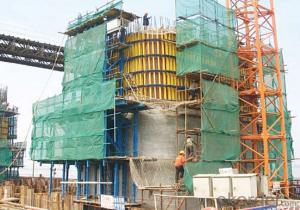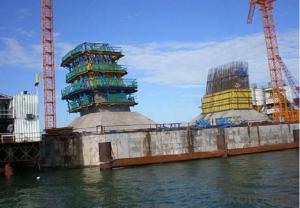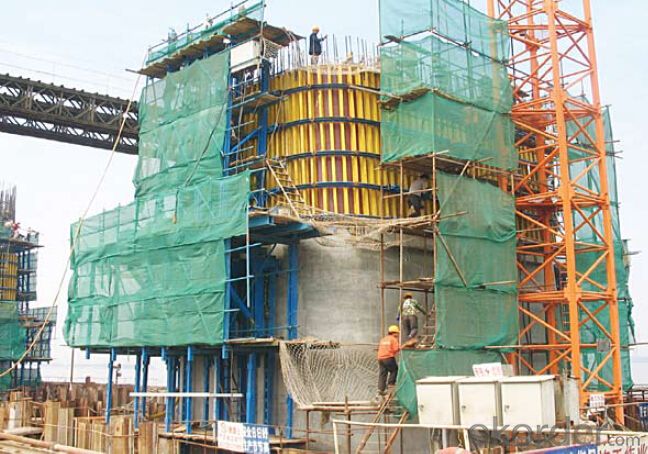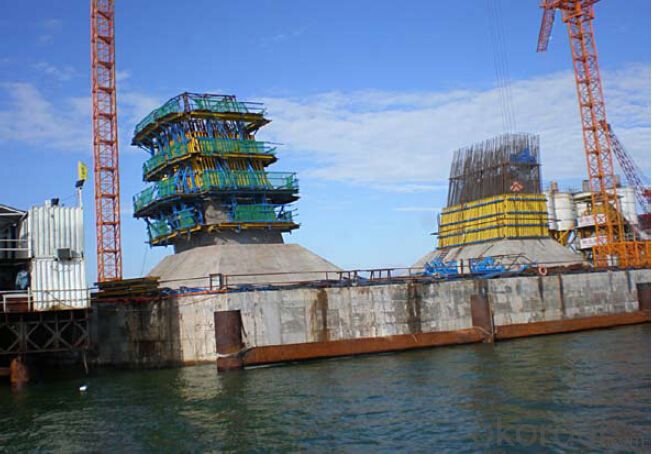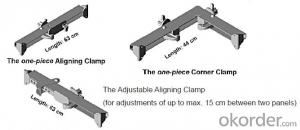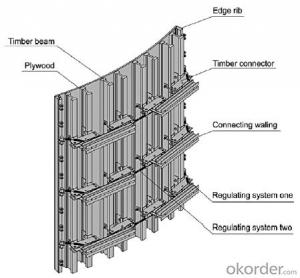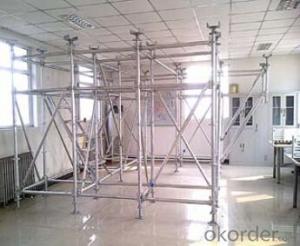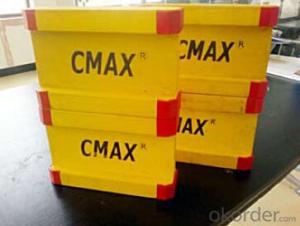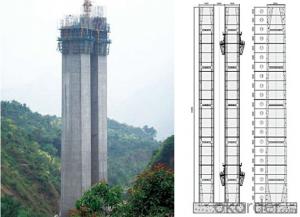Auto Climbing bracket ACB-100 for formwork and scaffolding system
- Loading Port:
- Tianjin
- Payment Terms:
- TT OR LC
- Min Order Qty:
- 50 m²
- Supply Capability:
- 1000 m²/month
OKorder Service Pledge
OKorder Financial Service
You Might Also Like
Auto-climbing Bracket ACB100 & ACB50
The power of the auto-climbing formwork is the hydraulic system, which includes the oil cylinder
and two commutators. The commutators can control the climbing of climbing rail and the bracket.
The steel rail and the bracket can inter-climbing, so the whole system will climb up steadily.
Cranes are not needed during the construction. It’s easy to operate, highly efficient and safe. It’s
the best choice for the construction of high buildings and bridges.
There are mainly two types of standard auto-climbing brackets, ACB-50 and ACB-100, the figure
means the push power of cylinder with unit of KN.
Characteristics:
◆ Perfect load bearing anchor system
Anchor system is the most important supporting part. The system is made of five parts shown
below. Thereinto, tensile bolt, V-climbing cone and washer can be taken out for reusing after the
concrete pouring finished.There are two kinds of anchor systems,A & B. A is matched with single
anchor shoe and B is matched with double anchor shoe.
◆ Crane-independent
Crane-independent forming, striking and climbing speeds up the work procedures on the
construction site and also makes them independent of each other. This means the planned
sequences can be maintained along with guaranteeing high productivity levels. The crane can
therefore be used for other tasks.
Hydraulic system is mainly made of two commutators,
oil cylinder and power distribution system.The
commutators can control the climbing of climbing rail
and bracket.
◆ High bearing capacity and safe
The stable working platforms are able to carry large loads, e.g. the storage of reinforcing steel
for the next climbing section. Generously-sized working platforms, the well thought-out design for
handling very high wind loads and the patented control function of the climbing mechanism are
some of the special details contained within the comprehensive safety concept.
◆ Platforms adjusted to suit the angle of inclination
The horizontal working areas thus created provide safe and comfortable conditions for
reinforcement work, shuttering and striking, concreting and finishing.
◆ The ACB formwork system can climb not only vertically but also slantways, the largest angle is
18 degrees.
◆ The system can climb up wholly or separately. The climbing process is steady, synchronous
and safe.
◆ The bracket will not fall to the ground until the construction is finished, the field will be saved
and the impacting breakage will be reduced (especially the panel).
◆ The system will furnish omnidirectional platform, the construction organizations don’t need to
set up additional operation platform.
◆ The error of structure construction is small and easy to correct.
◆ The climbing speed is fast, the construction course will be quickened.
◆ The formwork can climb itself and cleaning work can be done in the same situs , the used times
of tower crane will be greatly reduced.
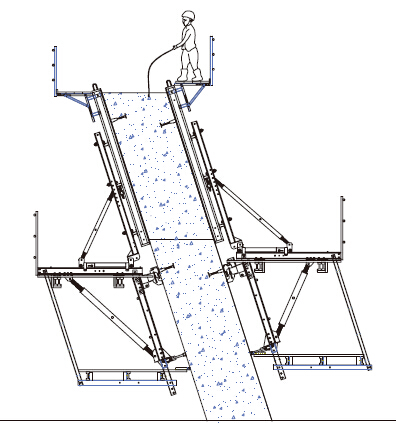
- Q: What are the different types of formwork clamps used in steel formwork?
- There are several types of formwork clamps that are commonly used in steel formwork construction. These clamps are designed to securely hold the formwork panels together, ensuring stability and accuracy during the concrete pouring process. 1. Wedge Clamps: Wedge clamps are one of the most commonly used formwork clamps. These clamps consist of a wedge-shaped piece that is inserted into a slot on the formwork panel. As the wedge is driven further into the slot, it creates a tight and secure connection between the panels. 2. Rapid Clamps: Rapid clamps are a type of formwork clamp that allows for quick and easy installation and removal. They are designed with a spring-loaded mechanism that allows the clamp to be easily tightened or loosened with minimal effort. 3. Turnbuckle Clamps: Turnbuckle clamps are adjustable clamps that are used to provide additional tension and support to the formwork panels. These clamps consist of a threaded rod with a turnbuckle mechanism that can be tightened or loosened to adjust the tension on the formwork. 4. Pipe Clamps: Pipe clamps are a type of formwork clamp that uses pipes or tubes to connect and secure the formwork panels. These clamps typically consist of a U-shaped bracket that is attached to the formwork panel and a pipe or tube that is inserted into the bracket to hold the panels together. 5. Panel Clamps: Panel clamps are specifically designed to hold large formwork panels together. These clamps typically consist of a large, heavy-duty clamp that can be tightened or loosened to securely hold the panels in place. Each type of formwork clamp has its own unique features and advantages, and the choice of clamp will depend on factors such as the size and weight of the formwork panels, the desired level of stability, and the specific requirements of the construction project.
- Q: What is the expected lifespan of steel formwork ties?
- Several factors, including the quality of the steel, usage conditions, and maintenance, can influence the lifespan of steel formwork ties. Generally, these ties are designed to have a long lifespan and can be reused multiple times. When high-quality steel formwork ties are used in appropriate conditions and properly maintained, they can endure for several years. By regularly cleaning, inspecting, and maintaining them, they can be reused for multiple construction projects, thereby reducing costs and waste. It is essential to note that steel formwork ties may deteriorate over time, especially when exposed to harsh environmental conditions or corrosive substances. Therefore, it is crucial to regularly inspect the ties for any signs of damage or corrosion and replace them if necessary. Additionally, proper storage and handling of the ties when not in use can also contribute to extending their lifespan. In conclusion, the lifespan of steel formwork ties is not fixed, but with proper maintenance and care, they can last for several years and be reused multiple times. This makes them a cost-effective and sustainable choice for construction projects.
- Q: How does steel formwork compare to other formwork materials in terms of cost?
- Compared to timber or plywood, steel formwork generally carries a higher price tag. However, when considering the overall expenses of a construction project, steel formwork has the potential to save costs in the long run. Although the initial cost of steel formwork may be greater, it boasts exceptional durability and can be reused multiple times without compromising its structural integrity. This reusability feature diminishes the need for constant replacement or repair, ultimately reducing the overall expenses for formwork materials in the long term. Furthermore, steel formwork provides unparalleled strength, stability, and precision in shaping concrete structures, resulting in a superior final product. This, in turn, can lead to reduced labor expenses and shorter construction durations, effectively counterbalancing the initial investment in steel formwork. Moreover, steel formwork offers heightened safety due to its fire-resistant properties and ability to withstand extreme weather conditions. This lowers the chances of accidents or damage during the construction process, which can potentially result in savings on insurance costs. Although steel formwork may initially be more costly than alternative materials, it offers a multitude of advantages that can lead to cost savings throughout the entirety of the construction process.
- Q: How does steel formwork handle formwork stripping?
- Formwork stripping is made easier with the use of steel formwork, which provides a sturdy and durable framework capable of withstanding the forces involved in its removal. Designed to be rigid and stable, steel formwork allows for efficient stripping once the concrete has cured. To remove the formwork panels or components from the concrete structure, the fasteners or connectors holding the formwork in place can be loosened. Steel formwork is commonly assembled with bolts, nuts, or other mechanical connectors, which can be easily undone during the stripping process. One advantage of using steel formwork is the smooth and clean surfaces it offers, minimizing the risk of concrete adhering to it while pouring and curing. This results in a simpler stripping process, as the concrete is less likely to stick to the steel surface. Moreover, the smooth surface allows for effortless cleaning and maintenance, ensuring its longevity and reusability. Additionally, steel formwork is renowned for its high strength and ability to bear heavy loads, allowing it to support the weight of the concrete during pouring and curing. This strength is also beneficial during the stripping process, as the steel formwork can withstand the pressure and forces involved without deforming or collapsing. Overall, steel formwork proves to be a reliable and efficient solution for formwork stripping. Its strength, durability, and user-friendliness make it a popular choice in construction projects that require quick and safe removal of formwork.
- Q: What is the steel formwork and its construction advantages
- Steel formwork is an energy-saving and environment-friendly products, after the wooden template, composite steel formwork, bamboo plywood, all steel template and a new type of product. Can completely replace the steel formwork, formwork, timber, traditional energy saving and environmental protection, low cost amortization.
- Q: Can steel formwork be used for concrete beams with varying cross-sections?
- Yes, steel formwork can be used for concrete beams with varying cross-sections. Steel formwork is versatile and can be easily adjusted and modified to accommodate different shapes and sizes of concrete beams. This flexibility makes it an ideal choice for construction projects that require varying cross-sections in the concrete beams.
- Q: What are the different accessories required for steel formwork maintenance?
- Some of the different accessories required for steel formwork maintenance include formwork release agents, cleaning solutions, wire brushes, repair materials such as epoxy or cementitious grout, lubricants for hinges and pins, and protective coatings for corrosion prevention. Additionally, tools such as hammers, wrenches, and pliers may be needed for minor repairs or adjustments.
- Q: Can steel formwork be used for both slab and column construction?
- Yes, steel formwork can be used for both slab and column construction. Steel formwork offers several advantages over other types of formwork, such as wood or plastic. It is highly durable and can withstand the pressure exerted by fresh concrete, making it suitable for use in both slab and column construction. For slab construction, steel formwork provides a strong and rigid support system, ensuring that the concrete is poured and cured in the desired shape and dimensions. The steel panels can be easily assembled and disassembled, allowing for efficient and repeated use on multiple projects. This saves both time and money in the long run. Similarly, steel formwork can also be used for column construction. The adjustable panels can be easily customized to various column sizes and shapes, providing flexibility in design. Steel formwork also offers a smooth surface finish, resulting in high-quality columns. Moreover, steel formwork is resistant to warping, swelling, and shrinking, which can occur with other types of formwork materials. This ensures that the concrete structure is built accurately and maintains its structural integrity over time. Overall, steel formwork is a versatile and reliable option for both slab and column construction. Its strength, durability, and ease of use make it a popular choice among construction professionals.
- Q: How does steel formwork handle architectural features such as openings and recesses?
- Steel formwork is a highly versatile and customizable solution that can easily handle architectural features such as openings and recesses. With its strength and flexibility, steel formwork can be shaped and adjusted to accommodate various shapes and dimensions, ensuring a precise fit. This allows for the creation of openings, recesses, or any other architectural feature required in the construction process. Additionally, steel formwork can be easily dismantled and reused, making it a cost-effective and efficient choice for handling complex architectural designs.
- Q: How does steel formwork handle different concrete testing procedures?
- Steel formwork is a popular choice in the construction industry due to its durability and versatility. When it comes to handling different concrete testing procedures, steel formwork is highly capable and efficient. Firstly, steel formwork can withstand the pressure and weight exerted by concrete during different testing procedures. Whether it is a compression test, slump test, or any other form of concrete testing, the robustness of steel formwork ensures that it remains intact and does not deform under the load. Secondly, steel formwork provides a smooth and even surface for concrete testing. This is crucial for accurate test results, as any irregularities or inconsistencies in the formwork can affect the quality and integrity of the concrete sample being tested. Steel formwork is known for its precision, ensuring that the concrete is poured and shaped precisely as required for each specific testing procedure. Moreover, steel formwork is adaptable and can be easily modified to accommodate various concrete testing procedures. It can be adjusted or reconfigured to meet the specific requirements of different tests, such as creating different shapes, sizes, or depths for concrete samples. This flexibility allows for efficient and accurate testing, as the formwork can be customized according to the testing procedure being carried out. Additionally, steel formwork is reusable, which offers cost-effectiveness and sustainability in concrete testing. Unlike other types of formwork that may need to be discarded after a single use, steel formwork can be dismantled, cleaned, and reused multiple times. This reduces the overall expenses associated with concrete testing procedures and minimizes waste generation, making it an environmentally friendly option. Overall, steel formwork is well-suited to handle different concrete testing procedures due to its strength, precision, adaptability, and reusability. It provides a stable and consistent surface for accurate testing, ensuring reliable results. With its numerous advantages, steel formwork remains a preferred choice in the construction industry for various concrete testing requirements.
Send your message to us
Auto Climbing bracket ACB-100 for formwork and scaffolding system
- Loading Port:
- Tianjin
- Payment Terms:
- TT OR LC
- Min Order Qty:
- 50 m²
- Supply Capability:
- 1000 m²/month
OKorder Service Pledge
OKorder Financial Service
Similar products
Hot products
Hot Searches
